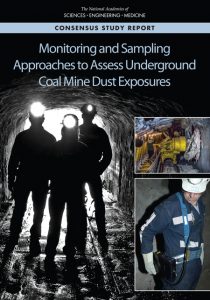MORGANTOWN —Incidence of black lung disease among miners has been increasing since 2000. West Virginia University public health professor Michael McCawley — who served on a panel for the National Academies of Sciences, Engineering and Medicine investigating the problem — believes that sending more inspectors underground to enforce regulations could help stem the problem.

McCawley made his comments in a WVU press release regarding the approaching 50th anniversary of the Coal Mine Safety and Health Act and the just-passed 50th anniversary of the Farmington Mine Disaster. He expanded on his thoughts in a phone interview with The Dominion Post.
“We concluded there was likely a gap in the administration of coal-mine-dust regulations, especially those that covered slope mining, a kind of mining that may involve cutting a lot of rock to reach a deeply buried coal seam,” he said. “Rock contains silica. Cutting it generates dust that is toxic because of its silica content. Inhaling this toxic dust is likely partly—or totally—responsible for black lung. But companies only have to sample dust when they are extracting coal, not as they are cutting the rock to access it. That means the period when silica exposure peaks is not reflected in the data they collect.”
 Sharing his own viewpoint, he said, “If you kind of gut an agency and expect it to do what it was doing before …. It’s kind of unrealistic.”
Sharing his own viewpoint, he said, “If you kind of gut an agency and expect it to do what it was doing before …. It’s kind of unrealistic.”
More inspectors have been needed for decades, and especially now. But politicians know regulations are unpopular, as are costs associated with regulations – especially when budgets have to be trimmed.
“We’re reaping some of the downside of that cost savings,” he said. Black lung cases are rising and dealing with that is expensive. “When medical costs go up everybody shares in that expense. If you don’t understand that when you’re doing your balance sheet … people pay the price and don’t know they’re paying it.”
The National Academies of Science Committee on the Study of the Control of Respirable Coal Mine Dust Exposure in Underground Mines came to Morgantown in June 2017 to hear testimony and share information about the reduction in dust levels since MSHA put in place its new respirable dust rule in 2014.
The committee released its report last June (In case you want to read it, you can download a free pdf or read it for free online; an e-book version is $54.99, the paperback is $70.) A release announcing the report says coal workers’ pneumoconiosis (CWP), better known as black lung disease, has seen since 2000 an unexpected increase among coal miners with 25 or more years of work tenure, and an increase or plateau of disease prevalence in those with shorter mining tenure.
“Moreover,” it said, “recent reports have described rapidly progressive, severe and fatal forms of disease including progressive massive fibrosis occurring mainly in the central geographic region of Appalachia.
“Effective exposure control,” it said, “is a key means of addressing the occurrence of CWP in coal miners. Effective monitoring technologies and sampling approaches would Effective exposure control is a key means of addressing the occurrence of CWP in coal miners. Effective monitoring technologies and sampling approaches would provide information on, not only the RCMD (respirable coal mine dust) mass concentrations for meeting regulatory requirements, but also the RCMD particle characteristics of greatest relevance to disease risk in miners.
McCawley said that the failure to sample dust during the cutting phase reflects a gap in the regulatory system that has to be filled. To do the job that needs to be done, MSHA needs more inspectors.
Understanding that nobody wants to increase the cost of regulations, he said somebody is going to pay the penalty down the road. And they’ll be paying not only with increased edical expenses, but with people’s health.
He said in the WVU release, “My friends in the United Mineworkers of America are quick to remind me that the regulations of today are written in the blood of miners of the past. As our panel from the National Academies learned, knowing what we should do is not sufficient. We have to actually do it, and we need to remain vigilant.”
Because of the holiday season, UMWA spokesman Phil Smith said he could not reach the people qualified to comment on the report and McCawley’s remarks. MSHA’s spokeswoman could not be reached for comment.



